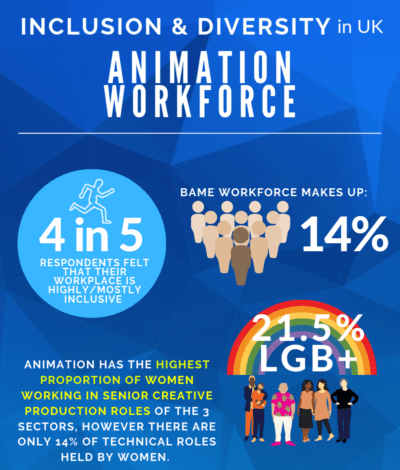Inclusion & Diversity in UK Animation Workforce: A Response
In September 2019 an infographic shared on Twitter from a 71-page document titled Inclusion and Diversity in the UK’s VFX Animation and Post-Production Sectors really drew my attention. “Really?” I thought “Really, really?”
The document is a collection of data that has been gathered by Screen Alliance UK in conjunction with Animation UK and Access VFX. It’s a comprehensive and, for the most part, thoughtful investigation into diversity within the animation sectors – but this infographic had me stumped. I have worked in animation for close to ten years, but perhaps I was alone in my experiences and perception of the industry? I asked around with BAME friends and colleagues. Apparently it didn’t correspond with their feelings or experiences either.
“Four out of five people found their workplace to be highly or mostly inclusive”. Yes, it was a surprise to me that so many felt that way. Personally, I felt this infographic was a misleading and precarious thing to push forward on publishing day. First off, it presents an appearance of the animation industry succeeding in achieving inclusion, which (according to the employment numbers within the same document) we are still failing to do. In fact, when all sectors were combined, fewer people felt their workplaces were inclusive. Secondly, if you read through the 71 pages, the feelings, attitudes and answers of it’s recipients reveals that the definition of inclusiveness for one person, isn’t the same to another.
I’m not here to pick holes in the survey or the answers given- I’m far from qualified to tell anyone how to conduct an extensive study into anything. Nonetheless, the responses within the survey raise an important issue that continually fails to be addressed- there does not seem to be an established, widely understood definition of what an “inclusive workplace” means. Instead, there seems to be an assumption of what it means to be “inclusive” but no conclusive understanding of what it looks like in practice. Because to me, inclusion isn’t just about opening the door to people, it’s about how they feel once they’ve walked through that door.
I am (what some prefer to refer to as) a BAME woman working in the animation industry. My experiences are within the 2D animation industry and often I am lucky enough to find myself surrounded by a wonderfully talented, friendly, fun crew. But during my working life, I have noticed the rarity of female or BAME directors and I have witnessed evident examples of employment and promotion based on friendships and university peer groups. But, perhaps most crucially, I have noticed how difficult it is to call out these damaging behavioural patterns. Because, while we all seem to agree that these unconscious (or conscious) biases should not be present within the workplace, there also seems to be an unspoken understanding that raising such issues isn’t something one should do. Frequently, when I have seen or heard of diversity issues being raised in person, they are met with accusations of complaining, exaggeration and fabrication. And when your career depends on recommendations and friendships, you have to be very careful about what you say and to whom. Perhaps it sounds like I’m doing that right now? Complaining? Exaggerating?
But I believe it is time for this conversation to be had- to be honest, open and forthcoming. It is my belief that inclusion means people feel valued and respected and it will take frank and authentic discussions to achieve that.
Diversity is being invited to the party; inclusion is being asked to dance.
-Vernā Myers
I’ve decided to focus on the BAME perspective, as I feel like it is rarely discussed or even acknowledged (though I’m certain many of these issues continue to be very similar for women in animation). Because, despite what many believe, it is not unusual for BAME creatives to still be treated as “the other” while at work. This manifests in different ways, sometimes it may be that they are actually subjected to ignorant (and sometimes plain racist) comments at work. On other occasions it may be more subtle- that they’re seen as a novelty, a person whose only value comes from their skin colour and that the only contributions they have to make are race-related. I have experienced and witnessed these situations on multiple occasions and heard of many more. Unsurprisingly, it’s a rather uncomfortable position to be in and is far from what most people would believe to be “inclusive”. Though perhaps it surprises you to hear these attitudes exist?

(Illustration by Tanya Scott)
That may be because more often than not, when I have these discussions with BAME colleagues, it is in a hushed corner away from the rest of the crew, or during a conversation in our own personal time. Simply put- the people who suffer from this kind of prejudice at work do not feel comfortable raising some of these serious issues with their employers or colleagues. When so many UK studios lack HR departments and almost all senior staff have never experienced a similar problem, it can seem too risky to discuss the problems openly. And it does feel like a risk- because no one wants to burn a bridge to further employment or success. I’ve heard of friends accused of being querulous by their directors, or being told that their issues are non-existent, just a “joke” they didn’t understand. And, as a result, there is a real belief among BAME colleagues that senior management will fail to understand or simply will not support them. So the responsibility to manage situations often falls on the shoulders of the person who wants to raise the issue, and as a result, it seems easier (and safer) to simply not mention it at all.
This isn’t just what I’ve heard, it’s what I have also experienced. I once casually raised awareness of the lack of diversity at one studio only to be met with the responses of “maybe women just aren’t good at directing” and “maybe black people just don’t want to work in animation”. As mid-level crew member I have also called out a creative choice which I found quite offensive, a choice steeped in historical racist stereotypes. The senior staff’s response to which was “it’s tongue and cheek” and it was brushed aside. The message was clear- they thought I was exaggerating- so I didn’t push back further and I was the one made to feel embarrassed, not them. On another occasion I have been told, quite openly by a colleague that “all Asians are weird” because (and I quote) “they eat dogs”. These experiences and examples may seem humorous to some, but they do contribute to building barriers. Those who face prejudice at work still have to maneuver around it or ignore it in order to get on with their working day. Constant choices have to be made about how and when to speak up and to whom to speak to. Having to be conscious of such decisions and feeling alone in taking them is far from “inclusive”- it is isolating and damaging on many levels.
Let me be clear, I think this document by Screen Alliance is a good thing. Taking scope of our industry and the progress we make is important. And I think for the most part, animation is full of fun, interesting, talented and accepting people who want to do right by each other. But there are consequences to sharing a misleading statistic like “four out of five people found their workplace highly or mostly inclusive”. It confirms to some that what they do not see, what they do not experience, does not exist.
Rather than creating safe spaces and open discussions, we continue to leave barriers where they stand because it seems just too inconvenient and unpleasant to discuss them. If we are truly serious about making a difference, we need to shift our working culture and our perspective. School visits and outreach programmes will help with making future workplaces more diverse, but if we want to create an inclusive workplace, it’s important we remember it’s not just about inviting people into a space- it’s allowing them to take up space. To be present and valued, heard and acknowledged, both personally and creatively.
The full report on Inclusion & Diversity in VFX, Animation and Post Production can be read at ukscreenalliance.co.uk


